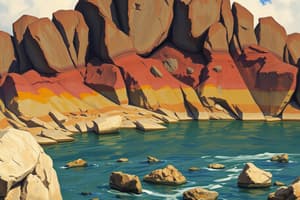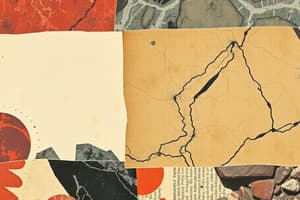Podcast
Questions and Answers
What type of rock is formed by the cooling of magma?
What type of rock is formed by the cooling of magma?
- Igneous rocks (correct)
- Foliated rocks
- Metamorphic rocks
- Sedimentary rocks
Which process is responsible for the transformation of igneous and sedimentary rocks into metamorphic rocks?
Which process is responsible for the transformation of igneous and sedimentary rocks into metamorphic rocks?
- Crystallization
- Erosion
- Metamorphism (correct)
- Weathering
Which of the following is an example of stratified rock?
Which of the following is an example of stratified rock?
- Granite
- Slate (correct)
- Marble
- Trap
What characterizes unstratified rocks?
What characterizes unstratified rocks?
Which type of rock is primarily composed of silica?
Which type of rock is primarily composed of silica?
Which rock type is characterized by having a tendency to split along a definite direction?
Which rock type is characterized by having a tendency to split along a definite direction?
Which type of rock cannot withstand shock and is brittle?
Which type of rock cannot withstand shock and is brittle?
What is the primary agent of transport for the products of weathering in forming sedimentary rocks?
What is the primary agent of transport for the products of weathering in forming sedimentary rocks?
Flashcards
Igneous Rocks
Igneous Rocks
Rocks formed by cooling magma, which is molten rock found beneath the Earth's surface.
Sedimentary Rocks
Sedimentary Rocks
Rocks formed from the accumulation and cementation of sediments, like sand or gravel.
Metamorphic Rocks
Metamorphic Rocks
Rocks that have been transformed by heat and pressure, changing their original composition and structure.
Stratified Rocks
Stratified Rocks
Signup and view all the flashcards
Unstratified Rocks
Unstratified Rocks
Signup and view all the flashcards
Foliated Rocks
Foliated Rocks
Signup and view all the flashcards
Silicious Rocks
Silicious Rocks
Signup and view all the flashcards
Argillaceous Rocks
Argillaceous Rocks
Signup and view all the flashcards
Study Notes
Geological Classification of Rocks
- Rocks are classified primarily based on their origin:
- Igneous rocks: Formed from the cooling of magma (molten rock). Types include Plutonic, Hypabyssal, and Volcanic.
- Sedimentary rocks: Formed from the deposition of weathered rock fragments. Agents like wind, water, and frost transport these fragments.
- Metamorphic rocks: Formed from pre-existing rocks altered by heat and pressure (metamorphism).
Physical Classification of Rocks
- Rocks are also classified by their structure:
- Stratified rocks: Layered structure, easily split along stratification planes. Examples include sandstone, limestone, and slate.
- Unstratified rocks: No layered structure, crystalline or compact grains. Cannot be split into thin slabs. Examples include granite, trap rock, and marble.
- Foliated rocks: Split along a definite direction, but not necessarily parallel. Common in metamorphic rocks.
Chemical Classification of Rocks
- Rocks are further categorized based on chemical composition:
- Siliceous rocks: Primarily silica, hard and durable. Examples include granite, trap rock, and sandstone.
- Argillaceous rocks: Primarily clay (argil), hard and durable, but brittle. Examples include slate and laterite.
- Calcareous rocks: Primarily calcium carbonate. Limestone (sedimentary) and marble (metamorphic) are examples.
Requirements of Good Building Stones
- Crushing Strength: Should exceed 100 N/mm².
- Appearance: Aesthetically pleasing, maintaining uniform color.
- Durability: Resistant to weathering, chemical attack, and other environmental influences. Factors include composition, texture, and location within the structure.
Studying That Suits You
Use AI to generate personalized quizzes and flashcards to suit your learning preferences.




